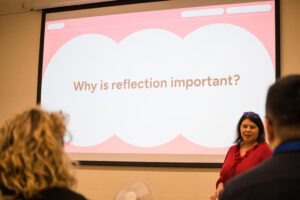It is March, so we are celebrating Work-Integrated Learning (WIL).
In case you were wondering, WIL is an educational approach that integrates academic learning with practical work experiences, providing students with the opportunity to apply theoretical knowledge in real-world settings.
By participating in WIL programs, students gain valuable hands-on experience, develop professional skills, and enhance their employability, bridging the gap between academic studies and the demands of the workforce. WIL fits in well with some of the overarching aims of education at JIBC, particularly in our credentialled programs where learners are trying to enter a new field of practice for their careers in the realm of public safety.
When we think of the highly experiential and hands-on learning available in post-secondary environments, we might consider such practices as practicums, co-op education, clinical placements and internships. Those are all versions of WIL, but there is more to it. Also, many of our programs are already hands-on, very applied and experiential, so what’s the big deal? WIL, in the formal sense, is a relatively new development at JIBC. While there have been aspects of work-integrated learning and efforts to bring hands-on learning to students, WIL has only been formalized as an institutional effort for the past few years, largely under the direction of Nina Bennett, who as the Program Manager of Work-Integrated Learning, makes it her primary focus to promote and support WIL initiatives at JIBC.
If you are wondering what all the fuss is about, then Nina is your first point of contact to learn more about what WIL is and what’s going on. With the support of some interpid early adopters, she has been building the WIL profile over the past few years, activity by activity and course by course, working to integrate WIL as a mainstream pedagogical strategy in our credentialled programs. This takes considerable effort to create partnerships, liaise between instructors and program administrators and community members, as well as a lot of curriculum re-design and development to ensure that work-integrated learning experiences become critical aspect s of the student learning experience in our programs in such areas as law enforcement, emergency management, health sciences and conflict resolution. There is now a WIL presence on the JIBC website that serves as the web-based home for WIL information, including information for both students and partners.
This edition of the Learning Hub provides an introduction to Work-Integrated Learning and all its different manifestations and component parts. For instructors and course developers, WIL offers a strategy that brings together some of the JIBC’s most compelling educational features and helps strengthen our connection with our community partners. Take a look, and if you want to be part of something that promises to give your classes that extra boost of pedagogical energy, then you might want to get in touch with Nina to discuss what’s possible.











